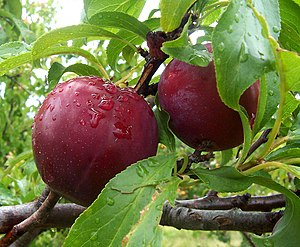 Gathering sliva is one of the pleasures of living in Bulgaria. The sliva tree is such a pretty sight when full of ripe fruit. There are so many varieties of sliva that come in all colours from pale yellow to almost jet black and all sizes from cherry size to bigger than golf balls.
Gathering sliva is one of the pleasures of living in Bulgaria. The sliva tree is such a pretty sight when full of ripe fruit. There are so many varieties of sliva that come in all colours from pale yellow to almost jet black and all sizes from cherry size to bigger than golf balls.Not all sliva is good for making rakia, some varieties just don’t have the body or natural sugar content to make decent rakia. The name of the game is to make the first fermentation as higher alcohol content as possible with the addition of sugar to supplement. You will se many trees that are not suitable for rakia making still with their fruits on right through to autumn as the Bulgarian won’t pick them and use them.
 Then there is the compote where the whole sliva fruit is jarred in a sugar-based syrup and eaten throughout the autumn, winter, following spring and beyond. The biggest, sweetest sliva is used for that and well worth the effort to make. The syrup from this is drunk and when the new season of sliva compote is made again the old stock is normally added to the rakia making sliva so there is now waste even from past the sell by date on sliva compote.
Then there is the compote where the whole sliva fruit is jarred in a sugar-based syrup and eaten throughout the autumn, winter, following spring and beyond. The biggest, sweetest sliva is used for that and well worth the effort to make. The syrup from this is drunk and when the new season of sliva compote is made again the old stock is normally added to the rakia making sliva so there is now waste even from past the sell by date on sliva compote.
Right now the sliva picking season is in full swing with an amount of excitement with the chores of gathering the crop. The thought of rakia ready to drink in a couple of months from this is always in the forefront of the gatherers minds. A winter stock of rakia and non alcoholic sliva compote is about to kick off.
 Then there is the compote where the whole sliva fruit is jarred in a sugar-based syrup and eaten throughout the autumn, winter, following spring and beyond. The biggest, sweetest sliva is used for that and well worth the effort to make. The syrup from this is drunk and when the new season of sliva compote is made again the old stock is normally added to the rakia making sliva so there is now waste even from past the sell by date on sliva compote.
Then there is the compote where the whole sliva fruit is jarred in a sugar-based syrup and eaten throughout the autumn, winter, following spring and beyond. The biggest, sweetest sliva is used for that and well worth the effort to make. The syrup from this is drunk and when the new season of sliva compote is made again the old stock is normally added to the rakia making sliva so there is now waste even from past the sell by date on sliva compote.Right now the sliva picking season is in full swing with an amount of excitement with the chores of gathering the crop. The thought of rakia ready to drink in a couple of months from this is always in the forefront of the gatherers minds. A winter stock of rakia and non alcoholic sliva compote is about to kick off.
![Reblog this post [with Zemanta]](http://img.zemanta.com/reblog_b.png?x-id=605789ef-1568-43bc-bdf7-ebf96bfda9f4)

![Reblog this post [with Zemanta]](http://img.zemanta.com/reblog_b.png?x-id=b811251f-adc5-4784-8c5d-321e67cd6d00)

![Reblog this post [with Zemanta]](http://img.zemanta.com/reblog_b.png?x-id=f6ebf2cc-03b6-4c13-a3d8-7538141c1fe9)


![Reblog this post [with Zemanta]](http://img.zemanta.com/reblog_b.png?x-id=3689b850-061f-43cc-92ff-aed6222eea46)
![Reblog this post [with Zemanta]](http://img.zemanta.com/reblog_b.png?x-id=63cc5698-24c4-485e-af29-f2894fda6078)

![Reblog this post [with Zemanta]](http://img.zemanta.com/reblog_b.png?x-id=7f6737d0-ccb8-4ecd-a1bd-bc0f434ba8f2)